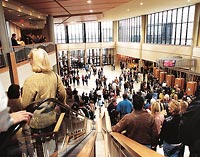
Photo: Alex Webb
In South Barrington, Illinois, just northwest of Chicago, lies a 155-acre campus resembling a junior college or perhaps a manufacturer of something clean, like pharmaceuticals or computer parts. On one side of the main compound is a greensward, on another side is a five-acre reflecting pond, and out in front are vast black slabs of endless parking, where swarms of men wearing reflective vests and radio headsets assist drivers attempting to find an open space. Shuttle buses loop around the lots; sometimes it’s so busy that off-duty cops are hired to help direct traffic.
It looks like a mall on a busy holiday weekend, but it is the Willow Creek Community Church, and it could be any weekend. In almost every city or suburb of more than 200,000 there is a similar megachurch, as they are known, a product of suburban sprawl, religious marketing, consumer demand, the entertainment economy, and the good old-fashioned yearning for communal experience. Megachurches draw young, committed, and energetic members; listen to parishioners talk and you will hear a refrain of growth—”we’re growing”—as if it were proof of redemptive success. And they deliver a highly emotional product: the marriage of group affiliation and a conversion experience, complete with videos, pop music, and other modern dramatic flourishes.
You might have predicted their rise from shifting demographics alone. Mainline denominations are drying up. In rural communities and cities, congregations of fewer than 100 are shutting their doors at a rate of 60 a week. Megachurches, meanwhile, have increased in number by 30 percent in the last four years. Out in the suburbs, Christianity is experiencing the same consumer shifts that occur when Sam’s Club or Costco comes to town. Megachurches can have congregations that are black or white, evangelical or not; half belong to no traditional denomination. Scholars call them “postdenominational churches” or parts of the “new apostolic reformation.” Their own laity call them “purpose-driven” or “seeker-sensitive” churches. Detractors call them McChurches or Wal-Mart churches. But whatever they are called, they deserve to be taken seriously, if only because they help explain why George W. Bush is still sitting in the Oval Office and how suburban malaise can be transformed into a multitude of organized, values-driven voters. Not by happenstance did Mel Gibson’s The Passion of the Christ play the megachurch circuit before making its theatrical debut. These are the churches that held get-out-the-vote rallies and stressed the importance of politics in the service of religion.
IN A SOCIETY where the average family moves every five years, where people have long commutes from exurb to office park and spend precious little time with family, much less neighbors, megachurches solve the problem of dehydrated community. Just appear, the megachurch says, and you are one of us. The size of congregations, far from being a deterrent, is a draw, providing the anonymity that allows the curious (“seekers,” in the parlance) to feel comfortable browsing for a church that suits their needs. From a doctrinal point of view, size is a natural byproduct of righteousness. Anyway, if it weren’t a good product, would so many people be buying it?
Megachurches don’t just physically resemble malls, they mimic the very essence of what a mall offers, consolidating convenience, entertainment, neighborhood, even employment. But in a larger sense, the megachurch resembles the Norman Rockwell town square—the commons. All churches promise forgiveness and salvation, but the key to the megachurch is that it provides all kinds of social services and functions that struggling old-line parishes have been forced to off-load. By taking on roles as various as those of the neighborhood welcome committee, the Rotary, the corner diner, the country club mixer, the support group—and, of course, family and school—megachurches have become the tightly knit villages that many Americans think they grew up in and can now find only on television. It’s no coincidence that so many megachurches have the word “community” in their names. In a sense they operate much like medieval city-states, and it is telling that a megachurch in Longmont, Colorado, plans to develop 313 surrounding acres into residences, a community college, and a senior center.
Suffixes of “community” and “church” aside, Willow Creek’s name came, appropriately enough, from the fact that the congregation once met in the husk of the Willow Creek movie theater. Rather like malls that take their names from what they destroy, this church takes its name from a competing form of entertainment.
Megachurches are designed to be familiar, nonthreatening, fun. The main entrance to Willow Creek is no portal done up like a passage into another world with a huge arch and gargoyles. Inside there’s not an ounce of old-time religiosity. No icons, no crucified Christs, no stained glass, no polished silver or gold. And no “Sunday best.” There’s an almost aggressive insistence on informality, as if to show the genuine nature of voluntary spirituality. The 7,200-seat gunmetal gray auditorium has stadium seating and automatic curtains that lower to create a calm half-light. As one Willow Creek official has said, “You can’t convince the unchurched that they have to sit on a hard seat in a draft for an hour every Sunday morning because that’s what people did 500 years ago.”
Down front is a floodlit stage with two 16-by-28-foot LED screens. When the pastor (although that term is rarely used—first names suffice) delivers the sermon (although “message” is the term of choice), these screens allow him to show a cartoon or filmstrip to illustrate his points. As with many megachurches, Willow Creek’s music is generated by a large live band, including electric guitars and saxophones. Churchgoers once had to squint at hymnals, but here projectors show the words (as well as the perpetual copyright notices) of the poppy songs.
These electronic altars may seem luxurious, but they are more practical than buying thousands of hymnals and prayer books. No mass page-flipping by parishioners, who are never lost during the service. The singing is uniformly booming and enthusiastic, partly because of the music’s catchy simplicity—no minor 18th-century composers here— but also because people have their chins up and their hands free.
In a reiteration of the medieval morality play, the Willow Creek service often kicks off with a playlet illustrating a workaday problem before the pastor, Bill Hybels, takes the stage. Well-scrubbed and casually dressed, he speaks about “virtue development” or “life at the boiling point” or some other general theme. Over the weekend there are three interchangeable, 30-minute “seeker services,” which the church has called, with deflective candor, Christianity 101. Midweek features a “believer service.” This is grad school, the place for real transcendence… and tithing.
The weekend seeker services, however, are aimed at the skeptical. Hence Hybels’ focus on a nurturing, forgiving God eager to help with the stresses facing most families. It goes without saying that religious explosions like this one depend on a charismatic character who spots the needs of a population, and Hybels is no exception. Looking over his sermons of the last decade, you can see a chicken-soup-for-the-soul inventory. Adjustment is key: adjusting to your children, to a spouse having an affair, to apathy, to abortion, to debt, to divorce, to drugs, to competition, to being lonely, to not measuring up, to repetition, to sloppiness, to lust, to anger, to being passed by, to racism, to growing older, and, well, to just about everything that men, especially, would prefer not to speak about in public. State-of-the-art duplicating machines guarantee that on the way out you can pick up a tape or CD of exactly the sermon you just witnessed so that you can revisit the coping lessons on your ride home.
In just 30 years, Willow Creek has become one of the nation’s largest congregations; 18,000 people attend services on any given weekend. And while independent of any top-down denomination, it has expanded sideways into its own Willow Creek Association—a national network of more than 10,000 institutions listed in an atlas of churches sympathetic to Willowesque branding. If this sounds suspiciously like a denomination, so be it. What it really represents is the franchising of a formatted service, the Home Depot of epiphany.
THE COMMUNAL APPEAL extends far beyond actual sermons. On one side of Willow Creek’s auditorium is a food court with seating for 750 and a mezzanine bookstore that offers 10,000 spiritually oriented titles. On the other side are the hushed executive offices of the church’s 500 employees and an industrial kiddie-care complex. During services, crawls on the Jumbotron screens announce, “the parents of child #267 need to come to the Sunday School.” With so many working parents worried about the welfare and whereabouts of their offspring, the megachurch, with its tremendous amount of youth programming—from organized sports to Bible study—aims to become the guardian of choice. Celebrity speakers, including Mr. T., Mel Gibson, Stephen Baldwin, and Randy Travis, add glitz, while communal celebrations—more than 750 people were baptized in the reflecting pond one summer—further bind the congregation together.
And then there are the “breakout” rooms of the church’s myriad self-help groups. Much like the old Communist Party, the entire Willow Creek enterprise is built on a network of interlinking cells, some 2,700 small groups, by the church’s own estimate. There are groups for singles, for couples, for recovering addicts—for every possible combination of identity or interest or problem.
Presiding over all these cells is Hybels, the genial paterfamilias. Back in 1975, at the age of 23, Hybels wondered why so many people claimed belief yet so few went to church. So he and some members of his youth fellowship went door to door asking questions. The answer was surprising. The impediment to family faith was, in a word, men. Men don’t like being religious in public. It’s not that they aren’t eager for the epiphanic experience; it’s that in the company of women, men don’t want to be ordered to sing, to say stuff, or to give anything. They don’t like losing control. Hybels learned that men are the crucial adopters in religion. If they go over the tipping point, women follow, children in tow. Hybels knew exactly how to comfort his “unchurched Harry.” He gave his parishioners a new name. They became known as “seekers.” And he gave the service a new name, too: “felt needs.” “Now let us pray” is not as efficacious as “Join me in prayer,” which is not as successful as what I heard at Willow Creek: “I’m going to pray, and you may want to join in.”
The sensitivity to male concerns is at the heart of Willow Creek’s appeal. All churches provide redemption, but few can provide a lasting community for men. To do that, Hybels created special men’s sections called Iron on Iron (a tip of the hat to Robert Bly), which hold seminars on subjects like “How a Man Grows in Christ” and “Building Purity.” Usually these groups meet in clusters of six to eight men, but there are occasional events for up to a thousand men. This move from squad to battalion is the key to male affiliation. As the owners of professional sports franchises have learned, if you can allow men to bond while maintaining the sense that everything is voluntary and unforced, they will form a nucleus of furious energy. They commit. Just look at season-ticket prices.
For years, a poster hanging outside Hybels’ office asked: “What is our business? Who is our customer? What does the customer consider value?” These questions are lifted not from Saint Peter, but from Peter Drucker, the patron saint of management.
Can the appeal of megachurches last? Willow Creek and its ilk are not just competing with other denominations, but with all other forms of entertainment, especially television. By intensely focusing on the needs of its congregation, by using sophisticated electronic showmanship, consumer-driven enterprises like Willow Creek can make the process of “doing church” incredibly compelling. Old-line faithful and secular urbanites may scoff at these one-stop- shopping malls of community and faith, but the needs that megachurches try to address are real. Modern society has created this market, and any religious institution or political movement that wishes to compete for this audience had better understand it.











